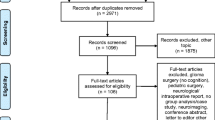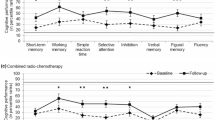Abstract
Cognitive impairment has been reported in 27–83 % of adults with World Health Organization (WHO) grade I–III glioma. However, the few studies in this field used different methods for cognitive assessment. The objective of the present study was to establish the prevalence of cognitive impairment in patients with WHO grade I–III primary brain tumors and determine the effect sizes of a comprehensive battery of tests. This study used a comprehensive neuropsychological battery to examine 27 patients. To control for false positives, prevalence was estimated from the overall neuropsychological score. Size effects were determined using Cohen’s d. Cognitive impairment was observed in 51.9 % (95 % CI 33−70.7 %) of the patients; the impairment affected action speed (38.5 %), cognitive (33 %) and behavioral (21.7 %) executive functions, oral expression (29.6 %), episodic memory (29.6 %) and visuoconstructive abilities (19.2 %). The largest effect sizes (d ≥ 1.645) were observed for the Digit Symbol Substitution test, global hypoactivity, free recall, Stroop time, the Boston Naming test (BNT), the Trail Making test B (TMTB), verbal fluency and the Rey–Osterrieth Complex Figure Test. Four of these scores (global hypoactivity, the Digit Symbol Substitution test, the TMTB perseveration, and the BNT) were combined to make a shortened battery (AUC 0.872; 95 % CI 0.795–0.949). The overall neuropsychological score was the sole factor associated with the functional outcome. Our results suggest that about half of survivors with a grade I–III primary brain tumor suffer from cognitive impairment. Tests with a large effect size should be included in future large-scale studies.

Similar content being viewed by others
References
Zouaoui S, Rigau V, Mathieu-Daudé H, Darlix A, Bessaoud F, Fabbro-Peray P et al (2012) French brain tumor database: general results on 40,000 cases, main current applications and future prospects. Neurochirurgie 58:4–13
Ostrom QT, Gittelman H, Liao P, Liu M, Blanda R, Kromer C et al (2014) CBTRUS statistical report: primary brain and central nervous system tumors diagnosed in the United States in 2007–2011. Neuro Oncol 16:iv1–iv63
Louis D, Ohgaki H, Wiestler O, Cavenee WK, Burger PC, Jouvet A et al (2007) The 2007 WHO classification of tumours of the central nervous system. Acta Neuropathol 114:97–109
Klein M, Heimans JJ, Aaronson NK, Van der Ploeg HM, Grit J, Muller M et al (2002) Effect of radiotherapy and other treatment-related factors on mid-term to long-term cognitive sequelae in low-grade gliomas: a comparative study. Lancet 360:1361–1368
Pahlson A, Ek L, Ahlstrom G, Smits A (2003) Pitfalls in the assessment of disability in individuals with low-grade gliomas. J Neurooncol 65:149–158
Ek L, Almkvist O, Kristoffersen Wiberg M, Stragliotto G, Smits A (2010) Early cognitive impairment in a subset of patients with presumed low-grade glioma. Neurocase 16:503–511
Habets EJ, Taphoorn MJ, Nederend S, Klein M, Delgadillo D, Hoang-Xuan K et al (2014) Quality of life and cognitive functioning in long-term anaplastic oligodendroglioma and oligoastrocytoma survivors. J Neurooncol 116:161–168
Van Loon E, Heijenbrok-Kal M, Van Loon W, Van den Bent MJ, Vincent AJ, de Koning I et al (2015) Assessment methods and prevalence of cognitive dysfunction in patients with low-grade glioma: a systematic review. J Rehabil Med 47:481–488
Vardy J, Wefel JS, Ahles T, Tannock IF, Schagen SB (2008) Cancer and cancer-therapy related cognitive dysfunction: an international perspective from the Venice cognitive workshop. Ann Oncol 19:623–629
Wefel JS, Vardy J, Ahles T, Schagen SB (2011) International cognition and cancer task force recommendations to harmonise studies of cognitive function in patients with cancer. Lancet Oncol 12:703–708
American Psychological Association (2010) Publication manual of the American Psychological Association, 6th edn. American Psychological Association, Washington, DC
Tressoldi PE, Giofre D, Sella F, Cumming G (2013) High impact = high statistical standards? Not necessarily so. PLoS One 8(2):e56180. doi:10.1371/journal.pone.0056180
Cairncross JG, Ueki K, Zlatescu MC, Lisle DK, Finkelstein DM, Hammond RR et al (1998) Specific genetic predictors of chemotherapeutic response and survival in patients with anaplastic oligodendrogliomas. J Natl Cancer Inst 90:1473–1479
Brott T, Adams HP, Olinger CP, Marler JR, Barsan WG, Biller J et al (1989) Measurements of acute cerebral infarction: a clinical examination scale. Stroke 20:864–870
Karnofsky DA, Burchenal JH (1949) The clinical evaluation of chemotherapeutic agents in cancer. In: MacLeod CM (ed) Evaluation of chemotherapeutic agents. Columbia University Press, New York, p 196
Godefroy O, Duhamel A, Leclerc X, Saint Michel T, Hénon H, Leys D (1998) Brain–behaviour relationships. Some models and related statistical procedures for the study of brain-damaged patients. Brain 121:1545–1556
Scheltens P, Leys D, Barkhof F, Huglo D, Weinstein HC, Vermersch P et al (1992) Atrophy of medial temporal lobes on MRI in “probable” Alzheimer’s disease and normal ageing: diagnostic value and neuropsychological correlates. J Neurol Neurosurg Psychiatry 55:967–972
Godefroy O, Azouvi P, Robert P, Roussel M, LeGall D, Meulemans T, GREFEX Study Group (2010) Dysexecutive syndrome: diagnostic criteria and validation study. Ann Neurol 68(6):855–864
American Psychiatric Association (2000) Diagnostic and statistical manual of mental disorders, 4th edn. American Psychiatric Association, Washington, DC
Folstein MF, Folstein SE, Mc Hugh PR (1975) Mini-mental state: a practical method for grading the cognition state of the patients for the clinician. J Psychiatr Res 12:189–198
Kalafat M, Hugonot-Diener L, Poitrenaud J (2003) Standardisation et etalonnage francais du mini mental state (MMS) version GRECO. Revue de Neuropsychologie 13:209–236
Raven JC (1965). Guide to using the coloured progressive matrices. Lewis Publisher, London
Fuhrer R, Rouillon F (1989) La version française de l’échelle CES-D (Center for Epidemiologic Studies-Depression Scale). Description et traduction de l’échelle d’autoévaluation. Psychiatr Psychobiol 4(3):136–166
Goldberg D (1988) Detecting anxiety and depression in general medical settings. Br Med J 297:897–899
De Renzi E, Faglioni P (1978) Normative data and screening power of a shortened version of the token test. Cortex 14(1):41–49
Colombo (1992) Adaptation française du test de dénomination de Boston, Versions abrégées. Revue europèenne de psychologie appliquée. 42 (1): 67–71
Albert ML (1973) A simple test of visual neglect. Neurology 23:658–664
Rey A (1959) Test de copie d’une figure complexe. Editions du centre de psychologie appliquée, Paris
Wechsler D (1997) Wechsler Adult Intelligence Scale, 3rd edn. Psychological Corporation, San Antonio
Van der Linden M, Coyette F, Poitrenaud J, et les membres du GREMEM (2004). L’épreuve de rappel libre/rappel indicé à 16 items (RL/RI-16). In: Van der Linden M, Adam S, Agniel A, les membres du GREMEM (eds) L’évaluation des troubles de la mémoire. Présentation de quatre tests de mémoire épisodique. Solal, Marseille, pp 25–47
Baddeley AD, Emslie H, Nimmo-Smith I (1994) Doors and people: a test of visual and verbal recall and recognition. Thames Valley Test Company, Suffolk
Godefroy O, Leclercq C, Roussel M, Moroni C, Quaglino V, Beaunieux H et al (2012) French adaptation of the vascular cognitive impairment harmonization standards: the Grecog-Vasc study. Int J Stroke 7:362–363
Godefroy O, Gibbons L, Diouf M, Nyenhuis D, Roussel M, Black S et al (2014) Validation of an integrated method for determining cognitive ability: implications for routine assessments and clinical trials. Cortex 54:51–62
Godefroy O, Roussel M, Leclerc X, Leys D (2009) Deficit of episodic memory: anatomy and related patterns in stroke patients. Eur Neurol 61:223–229
Cohen J (1988) Statistical power analysis for the behavioral sciences, 2nd edn. Lawrence Erlbaum Associates, Hillsdale
DeLong ER, DeLong DM, Clarke-Pearson DL (1988) Comparing the areas under two or more correlated receiver operating characteristic curves: a nonparametric approach. Biometrics 44:837–845
Brown PD (2003) Effects of radiotherapy on cognitive function in patients with low-grade glioma measured by the Folstein Mini-Mental State Examination. Am J Clin Oncol 21:2519–2524
Meyers CA, Wefel JS (2003) The use of the MiniMental State Examination to assess cognitive functioning in cancer trials: no ifs, ands, buts, or sensitivity. J Clin Oncol 21:3557–3558
Prabhu RS, Won M, Shaw EG, Hu C, Brachman DG, Buckner JC et al (2014) Effect of the addition of chemotherapy to radiotherapy on cognitive function in patients with low-grade glioma: secondary analysis of RTOG 98-02. J Clin Oncol 32(6):535–541
Meyers CA, Brown PD (2006) Role and relevance of neurocognitive assessment in clinical trials for patients with CNS tumors. J Clinical Oncol 24:1305–1309
Lageman SK, Cerhan JH, Locke DE, Anderson SK, Wu W, Brown PD (2010) Comparing neuropsychological tasks to optimize brief cognitive batteries for brain tumor clinical trails. J Neurooncol 96(2):271–276
Sichez N, Chatelier G, Poisson M, Delattre JY (1996) Gliomes sus-tentoriels: étude neuropsychologique des survivants à long terme. Rev Neurol 152:261–266
Pranckeviciene A, Adomas Bunevicius (2015) Depression screening in patients with brain tumors: a review. CNS Oncol 4(2):71–78. doi:10.2217/cns.14.60
Funding
None.
Author information
Authors and Affiliations
Corresponding author
Ethics declarations
Conflict of interest
O. Godefroy had partnership with Novartis and Pharnext for trials, speaker at symposia and advisory board meetings and the rest of the authors have no conflict of interest to declare.
Rights and permissions
About this article
Cite this article
Boone, M., Roussel, M., Chauffert, B. et al. Prevalence and profile of cognitive impairment in adult glioma: a sensitivity analysis. J Neurooncol 129, 123–130 (2016). https://doi.org/10.1007/s11060-016-2152-7
Received:
Accepted:
Published:
Issue Date:
DOI: https://doi.org/10.1007/s11060-016-2152-7




